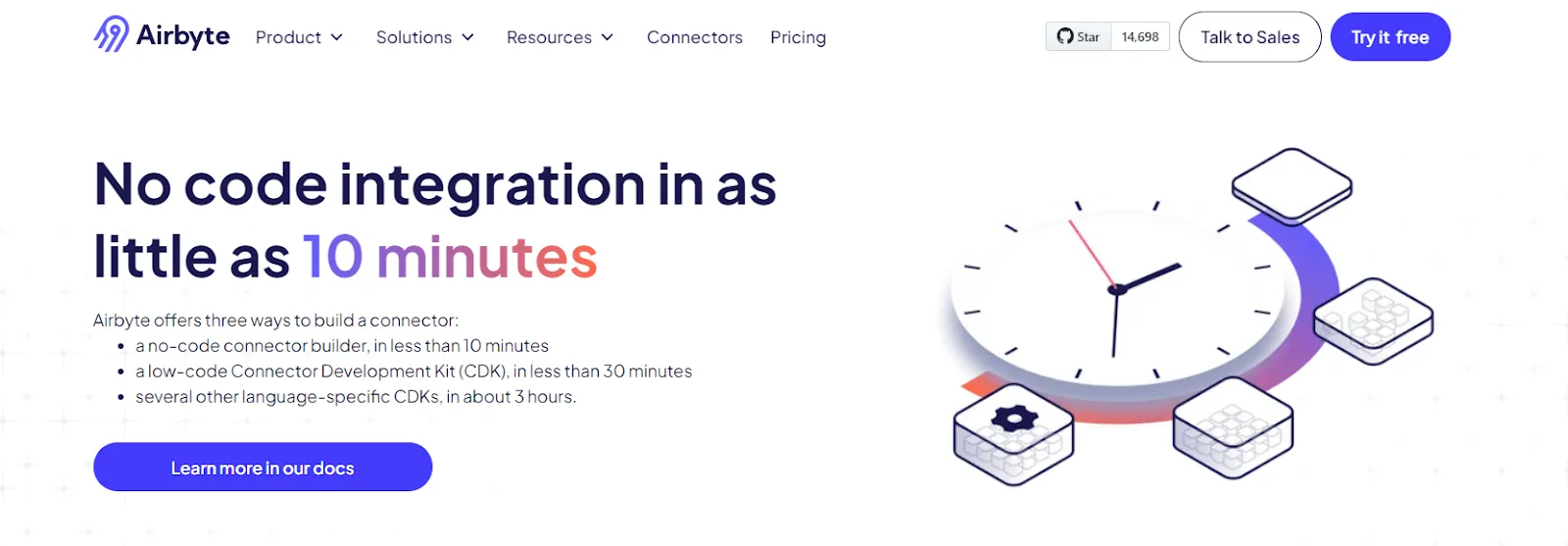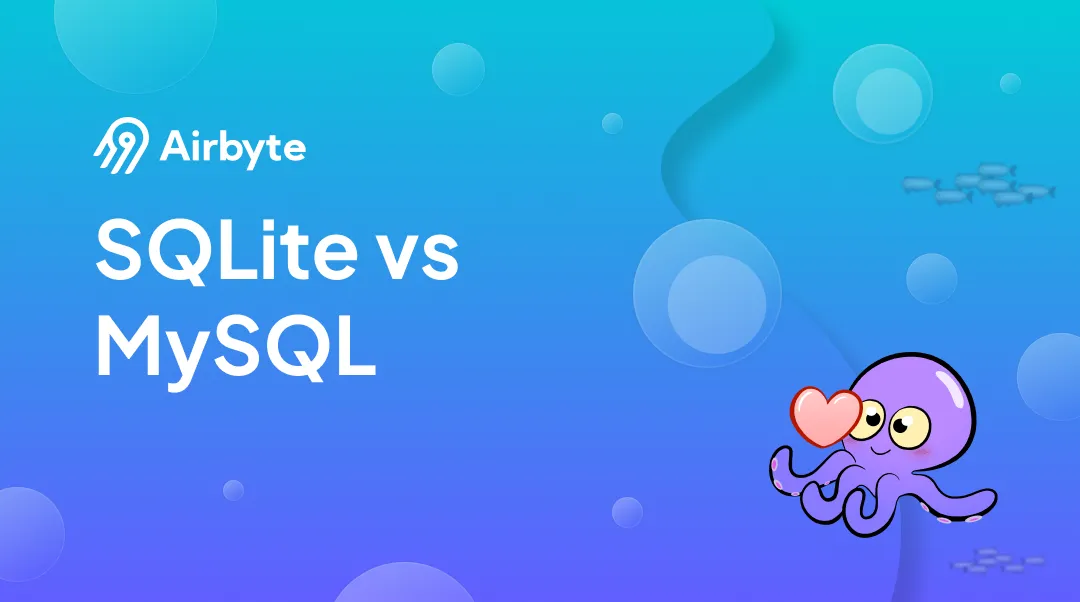SQLite vs MySQL: Features, Performance, and Use Cases
Summarize this article with:
✨ AI Generated Summary
MySQL is a scalable, multi-user RDBMS ideal for enterprise applications requiring complex transactions, strict security, and horizontal scaling, while SQLite is a lightweight, serverless database suited for embedded, single-user, and read-heavy workloads under 10,000 connections. Key differences include:
- MySQL uses static typing, supports multiple storage engines, and offers robust security features.
- SQLite features dynamic typing, minimal setup, and excels in portability and local read performance.
- Recent benchmarks show SQLite outperforms MySQL in read-heavy, low-concurrency scenarios, whereas MySQL leads in write-heavy, multi-user environments.
- Migration between the two is straightforward with tools like Airbyte, facilitating data integration and synchronization.
When designing modern applications, selecting the right relational database management system (RDBMS) is crucial. The long-standing debate of SQLite vs MySQL highlights how architecture, scalability, security features, and concurrency models can impact the trajectory of your project. This article compares the two databases in-depth—covering their SQL support, performance, and real-world use cases—so you can decide which database best fits your data management needs.
Takeaway
MySQL is a scalable, multi-user database management system ideal for enterprise and web applications, while SQLite is a self-contained, serverless database library perfect for embedded and single-user scenarios.
MySQL Overview
MySQL, created by Oracle Corporation, is an open-source relational database that follows a classic server-client architecture. Multiple users can connect—often over a network—to a central MySQL server that processes queries, manages storage engines, and enforces data integrity. According to recent DB-Engines rankings for 2024, MySQL maintains its position as the most popular open-source database management system worldwide, achieving a ranking score of 1061.

Key Features of MySQL
- Multiple Storage Engines – InnoDB, MyISAM, MEMORY, CSV, etc., allow administrators to fine-tune performance.
- Large Database Support – Tested with hundreds of millions of rows and terabytes of data.
- Rich Data-Type Catalog – Static typing with CHAR, VARCHAR, TIMESTAMP, ENUM, SET, DOUBLE PRECISION, and more.
- User Management & Security – Granular privileges, role-based access control, SSL/TLS, and encryption at rest.
- Horizontal Scaling – Replication, clustering, and sharding for many concurrent users.
- Recent Performance Improvements – MySQL 8.4.3 and 9.1.0 demonstrate substantial enhancements with approximately 7.25% average improvement for write workloads and 1.39% average improvement for read workloads.
SQLite Overview
SQLite is a lightweight, embedded database engine delivered as a C library. Unlike MySQL, it lacks a separate server process. The application links directly to the SQLite library, reading or writing to a single file on disk. This self-contained design makes deployment and portability a breeze—simply copy the file and your entire SQLite database (data tables, indexes, views, triggers) moves with it. SQLite's widespread deployment is remarkable, with over one trillion (1e12) active databases worldwide, driven primarily by smartphone adoption where each device contains hundreds of SQLite database files.

Key Features of SQLite
- Tiny Footprint – Core library ≈ 250 KB; full build ≈ 750 KB.
- Dynamic Typing & Storage Classes – Columns store whatever type fits the inserted value (NULL, INTEGER, REAL, TEXT, BLOB).
- Serverless Architecture – No client-server handshake; minimal latency for local operations.
- B-Tree Implementation – Efficient indexing and lookups, even in embedded environments.
- Write-Ahead Logging (WAL) – Optional journal mode boosting concurrent reads during writes.
- Enhanced Performance – Recent optimizations can reduce per-transaction overhead from over 30 milliseconds to under 1 millisecond through proper WAL configuration.
SQLite vs MySQL: Key Differences
In-Depth Comparison
Architecture & Storage Layer
- MySQL – Three-tier client, server, storage-engine stack. Server coordinates locking and streams data over TCP/IP or sockets.
- SQLite – Embeds a virtual machine inside the application; queries compile to bytecode executed in-process within a single file—no network layer.
Performance Benchmarks and Recent Findings
Recent comprehensive benchmark studies conducted on Ubuntu 24.04.1 LTS with modern hardware configurations reveal significant performance characteristics:
Concurrency & Transaction Management
Security Features and Recent Updates
Projects requiring strict regulatory compliance (HIPAA, PCI-DSS, etc.) usually need MySQL's security toolset, especially given the recent security enhancements in MySQL Enterprise Edition.
Scalability & Horizontal Growth
- MySQL – Supports replication, clustering, sharding. Tools like Vitess run MySQL at internet scale. Recent improvements in MySQL 8.4 include Tagged GTID functionality for enhanced replication control.
- SQLite – Designed for single-node deployments. Distributed variants (LiteFS, Turso) are emerging, with the embedded database market projected to reach USD 18.70 billion by 2031.
Data Types, Constraints & Integrity
Both databases support primary keys, foreign keys, and constraints. MySQL enforces constraints by default, while SQLite needs PRAGMA foreign_keys = ON;. Recent SQLite versions have introduced enhanced ALTER TABLE capabilities and window functions, bringing it closer to feature parity with larger database systems.
Real-World Use Cases
MySQL
- Websites & CMS – WordPress, Drupal, Magento.
- OLTP – Banking, ticketing, e-commerce systems requiring ACID and concurrency.
- Analytics Backends – Serves as a data warehouse source for BI platforms.
- Enterprise Applications – OneSource Virtual achieved 70% performance improvement migrating to MySQL Enterprise Edition.
SQLite
- Mobile Apps – iOS/Android (e.g., WhatsApp) for offline storage, with over 50% of applications utilizing local storage solutions.
- Browsers & Desktop Apps – Firefox history/bookmarks, Adobe Lightroom catalogs.
- Embedded & IoT – Tesla logs, smartwatches, other resource-constrained devices, with over 60% of IoT implementations leveraging embedded data solutions.
- Edge Computing – Growing adoption in scenarios where serverless architecture eliminates network latency.
Converting or Syncing Between the Two
Migration is straightforward because both support SQL. Typically export data from one system (SQL dump or CSV), adjust data types (e.g., TEXT → VARCHAR), then import into the other.

Move Data to MySQL and SQLite Using Airbyte
Airbyte is a modern ELT platform with over 600 pre-built connectors.
FeatureMySQL ConnectorSQLite ConnectorDirectionSource & DestinationDestinationIncremental SyncBinary log / CDCFull refresh or appendSetup NotesEnable binlog, create read-only userProvide path to SQLite fileBest ForReplicating operational DBs to warehousesLocal dev copies, offline dashboards
Database Management Best Practices
- Proper Database Design – Normalize schema and define clear relationships.
- Index Strategically – Speed up queries; monitor B-tree fragmentation.
- Backups & DR – Snapshot SQLite files or use
mysqldump/replication for MySQL. - Security Hardening – Enable encryption, enforce least privilege, audit access. Keep up with security patches, especially given recent vulnerabilities requiring immediate attention.
- Monitoring & Metrics – Track query latency and lock waits, especially for multi-user systems.
- Performance Optimization – Leverage recent MySQL performance improvements and SQLite WAL optimizations for enhanced performance.
Which Is Better: MySQL or SQLite?
The choice between MySQL and SQLite has become more nuanced based on recent performance data. 2025 benchmarks indicate that SQLite actually outperforms MySQL for read-heavy workloads with under 10,000 concurrent connections, challenging traditional assumptions about database performance hierarchies.
Choose MySQL when you need:
- Multiple concurrent users and complex transactions
- Strict security and compliance requirements
- Horizontal scaling and high availability
- Enterprise-grade features and support
Choose SQLite when you need:
- Lightweight, embedded, single-user scenarios
- Serverless architecture with minimal setup
- Superior read performance for smaller datasets
- Portability and zero-configuration deployment
- Edge computing and IoT applications
If you need to move or integrate data between the two, Airbyte's connectors can automate the process. Sign up for Airbyte to streamline your data pipelines.
Frequently Asked Questions (FAQ)
Can SQLite replace MySQL?
Recent performance improvements make SQLite competitive in many scenarios, but it still lacks native user management and high-concurrency support for multi-user applications.
Do SQLite and MySQL have the same syntax?
Core SQL is similar, but MySQL offers proprietary extensions (e.g., ENUM, SET) while SQLite uses dynamic typing. Recent SQLite versions have added PostgreSQL-style UPSERT functionality and window functions for better compatibility.
When should I avoid using SQLite?
Avoid it for applications with many concurrent users, strict security requirements, or the need for horizontal scaling. However, consider it for read-heavy workloads under 10,000 connections based on recent benchmarks.
Is it easy to switch from SQLite to MySQL?
Yes—migration tools and platforms like Airbyte simplify the process, though you must map dynamic types to static ones and consider recent security updates for both platforms.
Which is faster, SQLite or MySQL?
Based on recent 2025 benchmarks, SQLite is faster for local, read-heavy workloads and single-user scenarios, achieving the fastest select performance at 2.72 milliseconds. MySQL excels with heavy writes and concurrent users, particularly after recent performance improvements showing 7.25% better write performance.
Suggested read: MariaDB vs MySQL

.webp)
